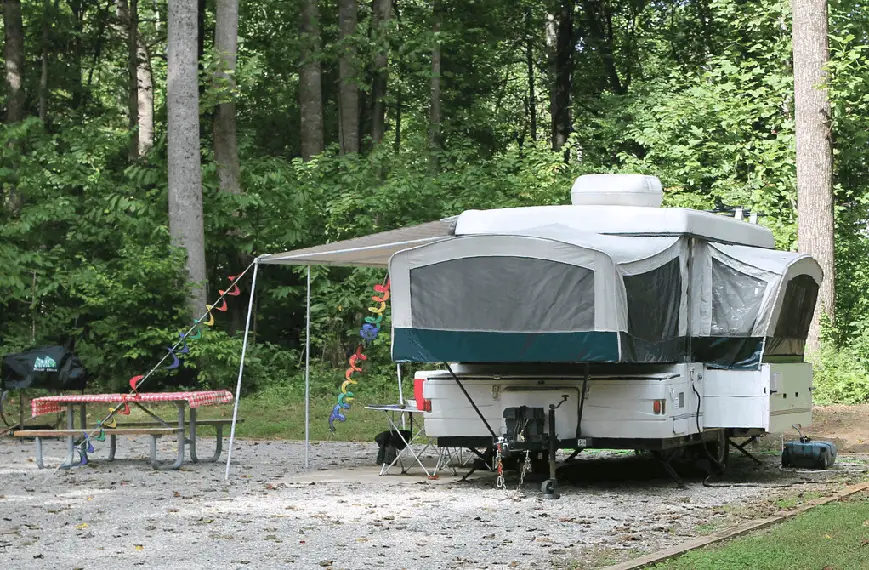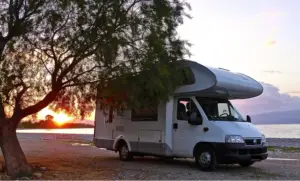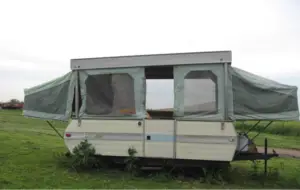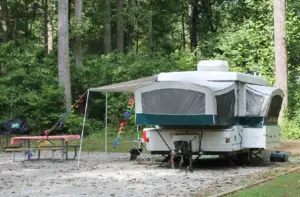Pop-up campers are Recreational Vehicles that can be collapsed for easy towing and storage. Their ability to transform makes them cool.
They are very popular with weekend getaways such as camping trips or just a backyard setup within your compound. Pop-up campers typically consist of inside areas used for sitting, sleeping, cooking.
But the overall space may not be great, using outside area could help boost the overall space. Many RVers make smart use awning to create such a space.
CAN YOU ADD AN AWNING TO A POP-UP CAMPER?
Awnings are the overhang coverings attached to campers mostly made of canvas or vinyl sheets stretched tightly over metal, plastic or wooden understructures for support.
You can add an awning to a pop-up camper as long as the camper is able to support the extra weight. Getting a bag awning rather than regular awning makes sense for them as they weigh less and are very easy to use.
Not all pop up campers are designed to have an awning however some do come equipped with awning from the factory itself.
DO YOU REALLY NEED AN AWNING FOR YOUR POP-UP CAMPER?
Campers can be retrofitted with awnings to protect against the seething rays of sun, rain, dust, and falling debris from trees.
They allow you and your mates to sit outside your camper comfortably as you play games, grill meat and take a cold drink. That makes an awning a necessity for pop-up campers, especially if there is not much space inside. The beauty about awnings is that you can buy as many as you want and add them interchangeably.
The many designs of awnings available create great aesthetic appeal on top of their broad functionality.
WHAT TYPE OF AWNING TO ADD?
Two factors should guide you on the type of awning to select: price and size. If you have a larger pop-up camper, you will need an expansive awning. To secure more affordable awnings, you will need to select those made from materials that are also affordable.
Automated awnings are generally expensive due to the cost of electric circuits and batteries that accompany them.
Let’s explore 5 common types of pop-up camper awnings;-
FIXED AWNINGS
Fixed awnings require zero mechanism or adjustments. They are, therefore, the easiest to set up. They are also simple in design, smaller in size compared to other awnings and are suitable for small pop-up campers where they are mostly fitted over doors and windows.
PATIO AWNINGS
They are named patio awnings because they look like the outdoor patio spaces used for dining when set up. These awnings are great for larger pop-up campers. They are composed of plenty of covering material and lengthy, strong retractable under structures.
When fully covered on the sides, they can be transformed into makeshift rooms for washing up and changing clothes. The chances are that if you purchase a bigger enough pop-up camper, you will get a patio awning offered free of charge.
ROLLER AWNINGS
They depend on the rolling mechanism; they are easily rolled out and anchored on top of your pop-up camper or detached, rolled up, and stored away from sight.
SLIDEOUT AWNINGS
To picture slideout awnings, think about sliding doors except that they lie vertically underneath or on top of the pop-up camper roofs. To set them up, you first slide out the supporting structure, a steady metal sheet such as aluminum, then stretch out the covering fabric.
AUTOMATED RETRACTABLE AWNINGS
Automated retractable awnings are high-end; spend extra money to obtain them and rid yourself of the struggle and time of setting up an awning yourself. They are easy to set up, all you need to do is press a button, and it will stretch out when you want to use it and fold up when you want to pack up drive away.
Some retractable awnings have sensors that can track the intensity of sunshine and wind and the camper’s movement to adjust accordingly. This added functionality can help protect your awnings from damage due to extreme weather conditions and movement when you drive away suddenly.
Always remember to remove your awning before driving out; if you don’t do so, it could get damaged, destroy property or hurt people around.
CONSIDERATIONS FOR ADDING AN AWNING TO A POP-UP CAMPER
Apart from the basic, that is, awnings’ price and size, you should consider other factors before adding an awning. They include; –
EASE OF USE
The last thing you want is to have a fancy awning that you cannot figure out. It may take you hours just to set it up, eating up quality time from your valuable camping schedule.
To pick up awnings that are easy to use, check out those with few component parts. They should be low in mechanical settings and high in automation. If you are not a technical guy, don’t use electric awnings that promise many features. You may find it difficult to adjust them when the need arises.
WEATHER CONDITIONS
Your local weather will dictate the type of awning to add and whether or not to add an awning at all. If you live where the weather changes rapidly, you should avoid automated awnings that have sensors.
Weather sensors are often very sensitive to slight changes in rainfall, sunlight, and wind. They would pull in and pull out periodically, creating a nuisance. In steady weather, electric awnings are the best for use. In fine weather with clear skies mild sunlight, you may not require an awning at all.
AWNING MATERIALS
Vinyl cover awnings dry faster and are hence are suitable for use in rain-laden areas. On the other hand, acrylic awnings make for great service in humid conditions.
Their woven fabric allows air to move, lessening the chance for the growth of mold and mildew. One principle you should follow to fight mold is never to roll up your awning when it’s wet.
Strong materials such as metal make for very durable awnings. If you are an avid camper, you should consider awnings made of durable materials. It would be cheaper in the long run because they would stay in good shape many trips after.
If you camp once in a while, though, you can select affordable awnings constructed from less durable materials such as wood and plastic. Own a variety of them to reduce the tear and damage that comes with the frequency of use.
YOUR CAMPING ITINERARY AND DURATION
Going out camping should not be a walk in the dark. You need to plan it, map out your itinerary, and study your camping locations’ conditions. With all this information at hand, you are better placed to select a suitable awning.
For instance, if you will be camping over the weekend, further away from sources of power, an electric awning would not be appropriate. Its batteries could run out, or there could be problems with the motors rending your awning useless.
If you will be camping under the heavy overgrowth of tree canopies or in snowing zones, you will need very strong awnings to protect you from falling debris. Shorter camping trips to plain grasslands may not require awnings at all. Save yourself the trouble of carrying one.
HOW TO INSTALL YOUR AWNING ON A POP-UP CAMPER
All awnings have a covering fabric or sheet and a supporting structure. To install them, follow these three essential points;-
MAKE SURE IT FITS: conduct a few supporting structure measurements to know if the awning you intend to install would fit on your camper.
UNFURL OR SLIDE-OUT YOUR AWNINGS FULLY: don’t leave any covering material unrolled or inside the awning. A full role out ensures even use on the whole surface guarding against structural weakness from overuse.
STRETCH OUT STEADILY: whether it’s the covering fabric’s supporting structure, you should be steady when stretching them out. If you are too rough, you could tear or break delicate parts.
Follow the manual to the latter: every awning is different; you will need to follow the manuals’ point-by-point instructions to quickly and safely install your awning.
COST OF ADDING THE AWNING TO POP UP CAMPER
The cost of adding an awning is the price of the awning plus the installation labor.
Slide-out manual retractable awnings cost about $500 for the small size (2 feet by 3 feet), $1000 for the medium (4 feet by 8 feet), and $1500 for the large (6 feet by 15 feet).
Fixed awnings cost about $250 for the small size and $500 for the medium. There are rarely large fixed awnings.
Automatic or electric awnings cost about $1500 for the small size (2 feet by 3 feet), $2000 for the medium, and $3500 for the large.
The standard cost of labor for the non-automated awning installation is $60 per hour per person for small-sized awning, $120 for the medium-sized and $180 for the large.
The standard cost of labor for automated awning installation is $90 per hour per person for the small-sized awning, $180 for the medium, and $270 for the large.
HOW MUCH WEIGHT CAN YOU PUT ON A POP-UP CAMPER?
The sticker inside your driver door would let you know how much weight you can add to your pop-up camper; the towing weight. You can also check out weight requirements on your pop-up camper manual.
The heavier and sturdier your camper is, the more weight it can handle. To be safe, do not add more than 80 % of the towing weight recommended. This includes the awning that you carry with you.
CONCLUSION
So, do you really need an awning for your pop-up camper? Yes, you absolutely do, and you should consider adding one. Their benefits far outweigh their costs. They maximize your use of space and offer a fantastic camping experience.





